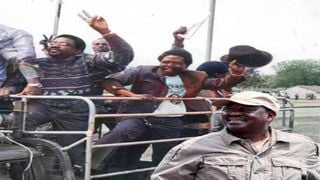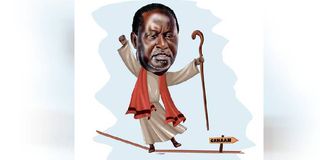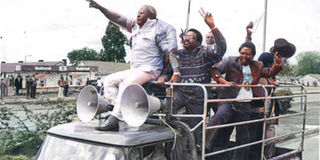
Opposition leaders heading to Kamukunji Grounds July 7, 1990. (inset) Azimio leader Raila Odinga.
| File | Nation Media GroupWeekly Review
Premium
Saba Saba ghosts: Can Raila Odinga rekindle the 90s revolution movement?
Selecting July 7 as the launch date for demonstrations focused on demands for repeal of the Finance Act, 2023 that underpins President William Ruto’s first budget might indicate opposition leader Raila Odinga’s exquisite sense of timing. Or show up a leader hopelessly trapped in history.
For an older generation, July 7, or Saba Saba (Seven Seven), marks that portentous day in 1990, which signalled the beginning of the end of one-party dictatorship in Kenya.
It is a day revered for unprecedented defiance in a police state era, when even with their leaders arrested, thousands of citizens heeded calls to attend a pro-democracy rally at Kamukunji grounds to push the drive for an end to the dictatorship then exemplified by President Daniel Moi’s monolithic Kanu machine.
Police out to disperse the crowds by whatever force necessary met a populace no longer cowering in fear. The battles between police employing tear gas, truncheons and bullets up against youthful, stone-throwing protesters not only became the stuff of legend, but was widely recognised as the turning point in the struggle for democracy and human rights.
That was the day leaders of the nascent democracy movement – including a youthful Raila himself; fellow Young Turks such as James Orengo, now Siaya Governor, and lawyers Paul Muite and Gitobu Imanyara, who both later became MPs; and campaign icons Kenneth Matiba, Charles Rubia, Martin Shikuku and Raila’s father, Oginga Odinga – called a rally at Kamukunji to press the campaign launched four months earlier for revival of the multi-party system.

The rally was declared illegal and on the eve of the day, key proponents – Matiba, Rubia and Raila – were arrested and thrown into detention cells.
Those were the days the government had power to arrest and imprison without trial any person it wished to restrict.
One of the lesser-known victims of the arrests was a young lawyer in Muite’s firm, Mohammed Ibrahim, now a Supreme Court judge.
Muite escaped the dragnet and went into hiding, while a legal colleague, Gibson Kamau Kuria, sneaked out of the country ahead of his pursuers.
But a few of the key campaigners, Shikuku and Orengo being the most prominent, eluded police. On the material day, they sneaked past the security cordon and drove triumphantly towards Kamukunji atop a pick-up, making one of the most iconic photographic images of Saba Saba.
More than 30 people died, nearly all at the hands of police. More than 1,000 were arrested and charged with a variety of offences around illegal assembly and processions, breach of the peace and disorderly conduct.
The state won the battle but lost the war, for by the end of 1991, the once impregnable Moi regime relented and acceded to demands for an end to the one-party system.
Since then, Saba Saba has been the rallying cry for numerous initiatives aimed at transformation of the constitutional, legal, economic and social landscape.
This was most evident after Moi returned to power in 1992, when civil society luminaries led by lawyer and former political detainee and exile Willy Mutunga launched a drive for constitutional reform to place the country on firmer democratic ground.
The campaign picked up steam ahead of the 1997 elections by choosing July 7 as the launching pad for monthly demonstrations, to be followed by Nane Nane (Eight Eight) on August 8, Tisa Tisa (Nine Nine) on September 9 and so on.
The demonstrations, which turned into running battles with police, combined with plans for a National Convention that aimed at proclaiming its “sovereignty”, forced Moi to give way. The outcome was the Inter-Parties Parliamentary Group talks that effected limited constitutional reforms before the 1997 General Elections.
But the Spirit of Saba Saba, also referred to as the Spirit of Ufungamano after the church hall next to the University of Nairobi that was the nerve centre of the campaign, lived on.
It was crucial to final realisation of the new Constitution in 2010 midwifed by President Mwai Kibaki and Raila, who was premier in the Grand Coalition government. It is thus easy to see the spirit Raila seeks to invoke by settling on the coming July 7 as a launchpad for demonstrations.
The opposition veteran had launched his demonstrations in March as part of continuing protests against Ruto’s electoral victory. His key demand was “Open the Servers”, as he sought to prove his contention that scrutiny of the Independent Electoral and Boundaries Commission election results database would show that he was the actual winner of the August 2022 presidential poll.

Opposition leaders heading to Kamukunji Grounds July 7, 1990. A minute’s silence in memory of the martyrs of the Second Liberation on the 32nd anniversary of the bloody protests against draconian laws would be a fitting tribute by Azimio's Raila Amolo Odinga and his running mate Martha Karua.
For good measure, he also sought to tap into growing public disenchantment with Ruto’s Kenya Kwanza administration by demanding reductions in prices of food, petrol, electricity and other basics.
Eventually, Ruto conceded to some extent by agreeing to dialogue, which was to be driven by a 14-member parliamentary team with equal numbers from Kenya Kwanza and the opposition Azimio la Umoja-One Kenya alliance.
The talks never really got going, and Raila had already suspended participation by the time the Finance Bill – which details the revenue-raising and spending proposals of the Ruto government – made it to Parliament.
Kenya Kwanza used its numerical muscle to force easy passage of the bill with the contentious taxation proposals intact, and that provided the perfect excuse for Raila to take to the streets again. It was at the public “consultations” at the Kamukunji grounds on Tuesday that a series of resolutions were passed, including pulling out of the parliamentary talks and starting a nationwide demo to press for recall of the taxation laws.
But it was not just about the Finance Bill. Speaker after speaker at the rally, dwelt on forcing Ruto out of power. Raila, his 2022 presidential election running mate, Martha Karua, and other Azimio principals such as former Defence CS Eugene Wamalwa and former Kakamega governor Wycliffe Oparanya, said the ultimate aim is a “people power” removal of the Kenya Kwanza regime.
The Azimio luminaries may well be confident that in pushing through highly unpopular taxes, Ruto has given them the rope to hang him. They talked of extending protests that were previously confined to Nairobi and Kisumu to all parts of the country, citing the fact that high taxes and increased consumer prices hurt everybody.
Raila gave a long history of Saba Saba, concluding that the spirit which forced strongman Moi to give way should have no trouble sweeping Ruto away.
Public discontent
While there is certainly plenty of public discontent to exploit on the back of Ruto’s failed election promise of immediate relief on cost of living, Raila might have neglected the fact that the bulk of his audience might have no Saba Saba memories to rekindle.
July 7, 1990, will be 33 years ago to the day come Saba Saba 2023. A quick review of video footage from last Tuesday’s Kamukunji rally showed that a clear majority of those in attendance were young men and a few women in their late teens and, at best, early 20s.
They were not yet born at the original Saba Saba, and therefore would have nothing to resonate with that date. Even those in their 40s present last week would in 1990 have been below mid-teen, and with very little recollection of the momentous events and their significance.
While Raila undoubtedly has a lot of grievances to capitalise on, he has to consider that the here and now would, for a majority of those he is calling out into the streets, be much more important than Saba Saba or the entire history of the multi-party campaign. Many of them would have no recollection or experience of life under the police state of the one-party regime.
Still, missteps of the Ruto regime around the dire state of the economy provide a potent cause for any anti-government agitation. If lessons from the previous rounds of demonstrations are anything to go by, Nairobi and Kisumu, at least, have thousands of disaffected and angry youth just waiting for the signal to take to the streets.
The sour aftermath of the Finance Act might provide fodder for captive ears in Mombasa and other parts of the coast region, western Kenya, eastern region, and probably pockets in some urban areas of Kenya Kwanza strongholds in the Rift Valley and Mount Kenya.
The intensity will depend on if Raila still has the capacity to mobilise and organise, and the counter-measures government will deploy.





